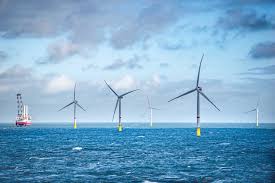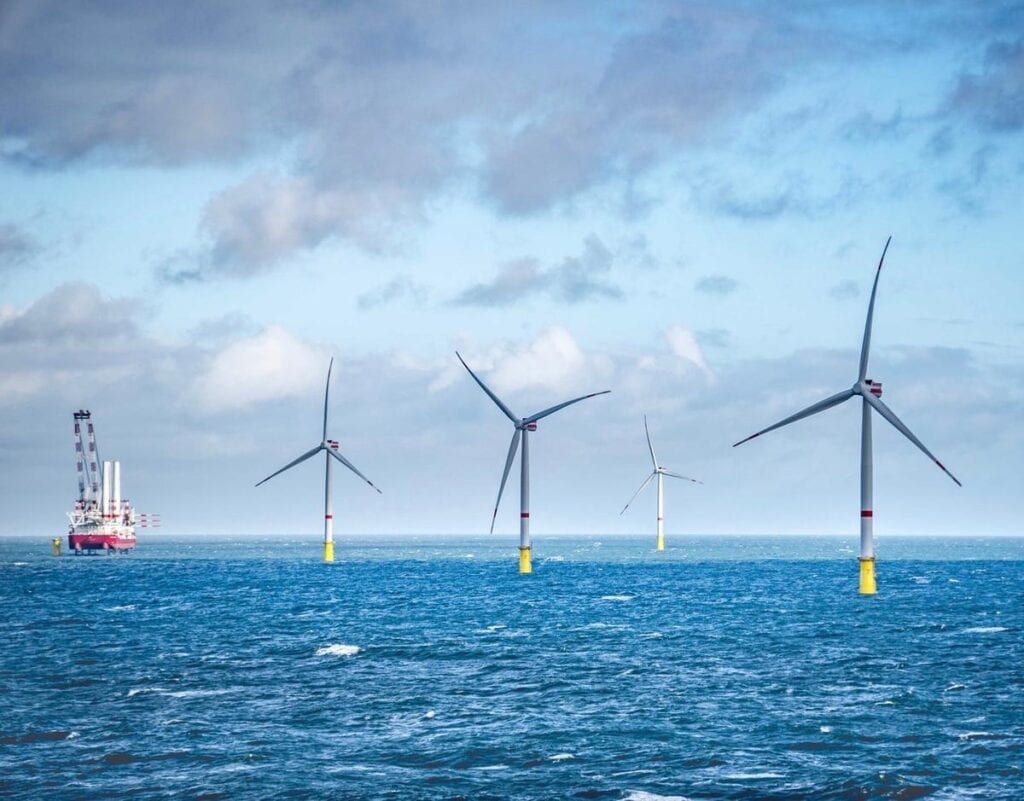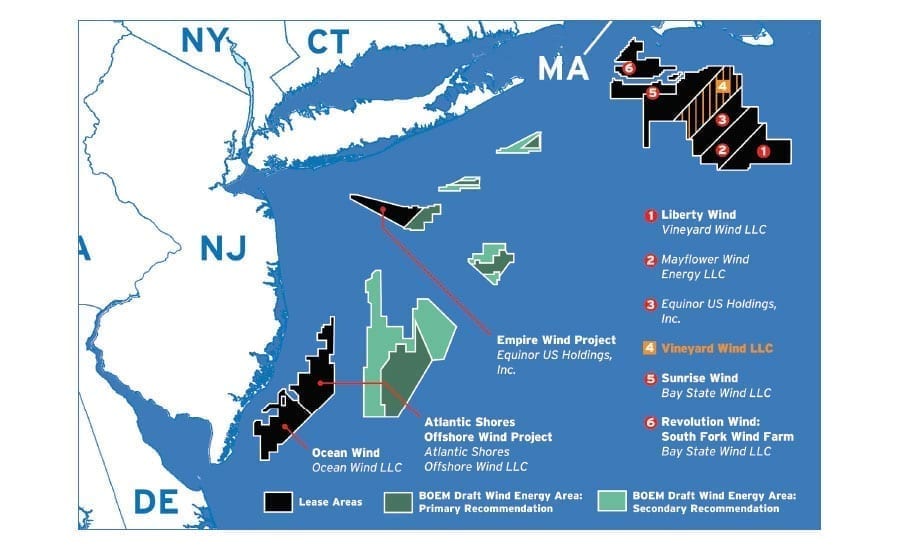Vineyard Wind Secures Transmission Agreement With ISO-NE
The post Vineyard Wind Secures Transmission Agreement With ISO-NE appeared first on POWER Magazine.

Vineyard Wind has announced a transmission agreement with ISO New England (ISO-NE) to deliver power to the system operator's grid when the Vineyard Wind 1 project comes online. The 800-MW offshore wind farm, located about 15 miles off the cost of Martha's Vineyard in Massachusetts, is expected to be the first commercial-scale offshore wind farm in the U.S.
The project, expected online in 2023, is a joint venture between Avangrid Renewables and Copenhagen Infrastructure Partners. The transmission agreement was announced Oct. 28, just days after the group said it had submitted bids in response to New York State's second solicitation for offshore wind power for its Liberty Wind project.
We're very pleased to reach this agreement, another important milestone in a project that will bring an entirely new industry to the U.S.," said Sy Oytan, deputy CEO of Vineyard Wind, in a news release. There is tremendous potential for job creation, not just during construction but also for operations and maintenance. These are good paying jobs that will be around for decades to come."
Mike Williams, an official with the BlueGreen Alliance, told POWER that job creation is among the most important aspects of offshore wind. The biggest drivers are policy, and job creation, from mine and our perspective," said Williams. Policy, like the state of New York puts forth a 9-GW procurement goal, and the state of New Jersey puts up a 7.5 GW, and now they're ramping it up. That's the huge driver of all of this, to make sure those commitments are locked in.
 A rendering of the Vineyard Wind project off Martha's Vineyard in Massachusetts. Courtesy: Vineyard Wind
A rendering of the Vineyard Wind project off Martha's Vineyard in Massachusetts. Courtesy: Vineyard WindAnd then job creation," he continued. Offshore wind [installations] are large infrastructure projects, and you need highly skilled, highly trained people to build them. This is hundreds of people building these projects, and there's going to be a number of people maintaining these. There are a lot of economic opportunities in engineering and design. We have to make sure we realize the job creation potential of offshore wind, to make sure when the policies are drafted that these are good jobs. It's not just a talking point, it's a reality."
Oytan Experienced in Offshore WindOytan was appointed deputy CEO on Oct. 1, replacing Alan Hannah, who joined Vineyard Wind in 2019 to oversee management of the company and focus specifically on the finance and business case development for Vineyard Wind projects. Hannah is remaining with Vineyard Wind during a transition period. The Vineyard Wind project has moved forward despite delays as the federal government reviewed its environmental impacts.
Oytan joins Vineyard Wind from Arup, an international offshore wind consultancy. He recently led several offshore wind port and supply chain initiatives for the state of New Jersey as part of a $400-million strategic investment plan.
Wednesday's announcement comes two days after the Business Network for Offshore Wind, a trade group for the industry, released a white paper that said the absence of a coordinated transmission policy for offshore wind is an existential constraint upon the ability of the OSW industry to reach its full potential in the U.S. market." The Federal Energy Regulatory Commission (FERC) held a technical conference Tuesday to discuss whether existing regulatory policy can accommodate the expected rapid growth of the U.S. offshore wind market.
 This map shows the location of several U.S. offshore wind projects. Source: BOEM
This map shows the location of several U.S. offshore wind projects. Source: BOEMThe trade group's study said that While there is debate about the optimal configuration of offshore transmission and the onshore grid upgrades necessary to integrate it, a planned transmission strategy is almost always ultimately more efficient than an unplanned, project-by-project approach." The study said more than 52 GW of proposed offshore wind interconnections are in the queues for the PJM Interconnection, New York ISO, and ISO New England.
FERC Chairman Neil Chatterjee on Tuesday during a webcast of the agency's conference said, The issues we're tackling today regarding offshore wind infrastructure are timely and critical. It's no secret that our energy mix is changing, and changing rapidly. There are multiple factors driving investment in the U.S. offshore wind industry and they show no signs of slowing down. We have to be clear-eyed about these trends and proactively engage with stakeholders."
Jessica Bayles, an associate in Stoel Rives' Energy Development group who often appears before FERC, said in an email to POWER that it was clear offshore wind is a significant portion of the portfolio that coastal states need and want to meet their renewable energy targets in the coming years." Bayles said better inter-regional transmission planning and cost allocation is needed for offshore wind to thrive, both in terms of necessary onshore upgrades and developing an offshore transmission system."
John Miller, a senior research analyst with Calvert Research and Management in the company's ESG group, recently told POWER that the U.S. is lacking is a coherent public policy program supportive of the offshore space. In the U.S., most prime offshore locations are owned by the federal government, requiring leasing and environmental negotiations with the Department of Interior's BOEM [Bureau of Ocean Energy Management]. Wholesale power markets are regulated by the federal government via FERC, but most of this day to day is executed by the ISO [independent system operator] or RTO [regional transmission organization], requiring successfully bidding into these markets. Lastly, the states dictate final rate structures for consumers, meaning a project will need to successfully manage the utility level offtake process. All three of these negotiations are time-consuming and lack developed processes or timelines. Further, all three of these negotiations can be project killers, either from an environmental/permitting perspective or from cost."
Connection to New England GridVineyard Wind in September received final acceptance for filing from FERC for the execution of its interconnection agreement with ISO-NE. The deal allows the first Vineyard Wind project to connect its generation into the New England electric power grid at the NSTAR 115kV switch station in Barnstable, Mass. Vineyard Wind has been selected to enter into power purchase agreements with Massachusetts power companies as part of the Section 83C of the state's Green Communities Act offshore wind solicitation.
Vineyard Wind last week said it responded to New York state's second solicitation for offshore wind capacity with proposals that include six options for up to 1.3 GW of generation. Vineyard Wind said that one of the options for its Liberty Wind project would represent the single largest direct economic benefit commitment of any offshore wind project in the United States to date."
For more information about the U.S. offshore wind industry, read Offshore Wind Finding Direction in U.S." in the May issue of POWER.
The Liberty Wind project includes installation of offshore wind turbines 84 miles east of Montauk Point. Vineyard Wind placed its bid with the New York State Energy Research and Development Authority (NYSERDA) as part of a tender for up to 2.5 GW of offshore wind. The tender was launched in July. This solicitation supports New York's goal to secure 100% of its overall electricity from renewable energy by 2040, and add at least 9 GW of offshore wind by 2035.
Other bids in the solicitation come from Denmark's Orsted and New England utility Eversource Energy, with their Sunrise Wind 2 project, along with Norway's Equinor, which has two proposed projects-Beacon Wind, and Empire Wind Phase 2. New York's Public Service Commission earlier in October adopted several changes from NYSERDA to expand the state's clean energy goals.
The Sunrise Wind 2 project, announced Oct. 20, includes comprehensive Port Infrastructure Investment Plans that will support the revitalization of New York's critical maritime infrastructure," according to the companies.
As the global leader in offshore wind and a proud partner of New York, Orsted understands the importance of achieving the state's renewable energy goals. We also have the unique opportunity to build a greener economy as the world rebounds from the COVID-19 pandemic," said Thomas Brostrom, CEO of Orsted North America, Offshore, in a statement. Our latest plan for New York provides statewide benefits and the potential to boost New York's green economy as we emerge from COVID-19. We are committed to doing everything we can to make New York's climate goals a reality, and to further strengthen its economy."
Other Wind Projects in DevelopmentOrsted and Eversource already are developing the 132-MW South Fork Wind project, New York's first offshore wind farm, which will serve Long Island. The companies' 880-MW Sunrise Wind 1 project was selected in a competitive solicitation in 2019 as one of NYSERDA's first offshore wind farms. The Sunrise projects, along with South Fork, all are sited more than 30 miles east of Montauk. Con Edison Transmission is supporting development of the grid connections for the projects.
Eversource is committed to helping New York reach its ambitious clean energy goals. As the nation's leading energy efficiency provider with more than 100 years of expertise partnering with Northeastern states to meet their policy goals, Eversource is well-positioned to serve as a catalyst for clean energy in the Northeast," said Joe Nolan, executive vice president for Strategy, Customer & Corporate Relations at Eversource. Sunrise Wind 2 will create good-paying jobs for New York, support economic growth, and further reduce emissions while delivering affordable clean energy to Long Island and the rest of New York. This latest proposal will deepen our commitment to New York State and the offshore wind industry."
The U.S. offshore wind industry is poised for expansion and we are passionate about creating substantial value in the New York market," said Siri Espedal Kindem, president of Equinor Wind U.S., in discussing his company's proposed projects. Equinor already is developing the 816-MW Empire Wind Phase 1 wind farm, which was selected in New York's 2019 offshore wind solicitation.
Oil major BP and Equinor in September formed a strategic partnership for offshore wind in the U.S. The $1.1-billion deal makes BP a 50%, non-operating partner in Empire Wind and Beacon Wind projects.
Empire Wind is located more than 15 miles southeast of Long Island and spans 80,000 acres. The project is being developed in two phases, with potential total installed generation capacity of more than 2 GW.
Beacon Wind is located 60 miles east of Montauk Point and 20 miles south of Nantucket, and covers about 128,000 acres. The project has potential total generation capacity of more than 2.4 GW.
-Darrell Proctor is associate editor for POWER (@POWERmagazine).
The post Vineyard Wind Secures Transmission Agreement With ISO-NE appeared first on POWER Magazine.